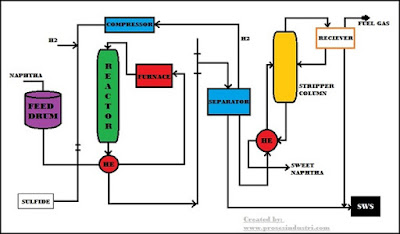NHT (Naphtha Hydrotreating) unit is a functional to perform the decomposition components of sulfur, oxygen, nitrogen, and metal compounds. as well as hydrogen of olefins contained in the heavy naphtha from the CDU (Crude Distillation Unit) and HCU (Hydro Cracking Unit) so that a sweet product naphtha. This sweet naphtha product will then be used as feedstock for platforming. Generally, this unit has a capacity of 20 MBSD (Million Barrel Stream Day), but there are also units with a capacity exceeding that amount.
The heating in the HE (Heat Exchanger) making the mixture undergo evaporation, this steam will then be heated in the furnace until it reaches a certain reaction temperature. However, if the catalyst used is still new, the heating in the furnace is usually not needed anymore because the last catalyst reaction can take place at a temperature of 315°C. The steam then piped to the reactor in which using Co-Mo catalyst.
Here is a reaction process that occurs in the reactor:
NHT Unit Process Systems
NHT receive feedstock in the form of heavy naphtha of CDU and HCU. Heavy naphtha will be streamed to the surge drum the injected hydrogen and dimethyl sulfate. The function of this injected is to activate the catalyst. The use of catalysts aiming to accelerate the reaction rate, but does not affect product quality. Then the mixture was heated in the heat exchanger to a temperature of approximately 324°C.The heating in the HE (Heat Exchanger) making the mixture undergo evaporation, this steam will then be heated in the furnace until it reaches a certain reaction temperature. However, if the catalyst used is still new, the heating in the furnace is usually not needed anymore because the last catalyst reaction can take place at a temperature of 315°C. The steam then piped to the reactor in which using Co-Mo catalyst.
 |
| Naphtha Hydrotreating Unit Flow Chart |
- Desulfurization: Aiming to reduce the sulfur content, the reaction that occurs between the sulfur-containing compounds with hydrogen will produce hydrogen disulfide.
- Denitrification: Aiming to reduce nitrogen content, the reaction that occurs between nitrogen and hydrogen would result Ammonium (NH3).
- Olefin Hydrogenation: Olefin hydrogenation is the reaction of olefins with hydrogen gas that will produce paraffin and naphthen.
- Decomposition of metal compounds: metals such as iron, calcium, magnesium, silica, and others will break down and are deposited on the surface of the catalyst.
Product from the reactor is cooled through heat exchanger (HE) and then the product is condensed in finfan, then injected the process water. Water injection is used to dissolve the salt formed. Mixture consisting of condensate and water are supplied to the separator so that there is a separation between gas, liquid hydrocarbon and water. Once separated, the water will be channeled to the SWS (Sour Water Stripper), while the gas will be supplied to the reactor through the compressor. While the liquid hydrocarbons from the separator will be heated using a heat exchanger until it reaches a temperature of 181°C. After that flowed into the stripper column. in the stripper column, the fluid will be heated using steam coming from the boiler. Steam is used to abolishing hydrogen sulfide, water and light hydrocarbons contained in the feedstock.
Steam coming from the top of stripper column is partially condensed in the overhead condenser, will then be channeled to reciever that serves to separate the condensate (liquid hydrocarbon) water and gas. Hydrocarbon liquid is returned to the stripper column as reflux, water flowed into SWS, while gas is used as fuel gas. Bottom product on a stripper column is a sweet naphtha will be feedstock for the process of platforming unit.
So in conclusion, reactions that occur in the NHT unit mostly using catalyst, while the steam from boiler is used to remove impurities. The purpose of this process is to produce a sweet naphtha which will be processed further in the platforming unit.
Steam coming from the top of stripper column is partially condensed in the overhead condenser, will then be channeled to reciever that serves to separate the condensate (liquid hydrocarbon) water and gas. Hydrocarbon liquid is returned to the stripper column as reflux, water flowed into SWS, while gas is used as fuel gas. Bottom product on a stripper column is a sweet naphtha will be feedstock for the process of platforming unit.
So in conclusion, reactions that occur in the NHT unit mostly using catalyst, while the steam from boiler is used to remove impurities. The purpose of this process is to produce a sweet naphtha which will be processed further in the platforming unit.

ijin mengcopy bung, terimakis, hatur nuhun, kamsiah, arigato dsb.
ReplyDeletematerinya membawa pencerahan buat saya, saya ada pertanyaan bisakah karbon aktif digunakan untuk bahan baku penyulingan minyak dan gas buminya ?